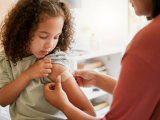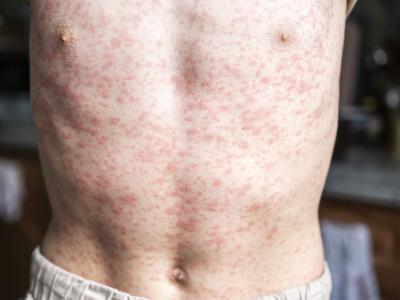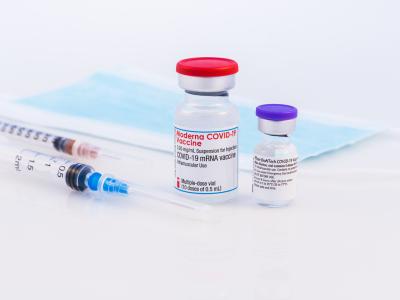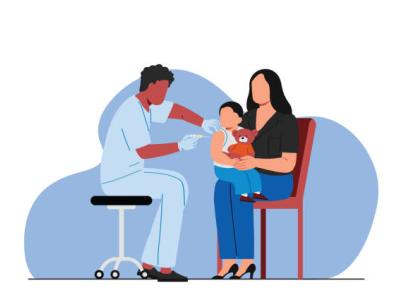Oct 25, 2006 (CIDRAP News) – A study involving tens of thousands of children has strengthened the evidence that influenza vaccination is safe for those 6 to 23 months old, an age-group for whom the government began recommending flu immunization 2 years ago.
The study, published today in the Journal of the American Medical Association, included 45,356 children at eight managed care organizations who received 69,359 doses of trivalent inactivated influenza vaccine (TIV) between January 1991 and May 2003.
The eight organizations are part of the Vaccine Safety Datalink project, supported by the Centers for Disease Control and Prevention (CDC), which gathers administrative data from all the organizations.
The researchers recorded any event that required medical follow-up during four intervals after vaccination: 0 to 3 days, 1 to 14 days, 1 to 42 days, and 15 to 42 days. They also included two control periods, one before vaccination and the other after 42 days postvaccination.
One diagnosis, gastritis/duodenitis, was more likely to occur within 14 days of vaccination, but after reviewing patient charts to exclude other possible causes of the condition, the researchers determined that the association was not significant. Yet they said they could not rule out a reaction to the vaccine and cautioned that the possible relationship bears watching as vaccination rates for young children increase.
Thirteen diagnoses were less likely to occur after vaccination, including acute upper respiratory tract infection, asthma, bronchiolitis, and otitis media.
The Vaccine Adverse Event Reporting System (VAERS) has reported that the most frequently reported adverse effects in children who receive the TIV are fever, rash, injection site reactions, and a small number of seizures, most of which were febrile, according to the CDC.
There were signs of a possible link between vaccination and seizures (convulsions), but chart review showed the link to be nonsignificant. The researchers found that most (22 of 24) seizures that occurred within 2 weeks of vaccination were febrile. Children often receive the influenza and measles-mumps-rubella (MMR) vaccines at the same office visit, and the MMR vaccine is known to increase the risk of febrile seizures, the report says. The authors observed that seizures were not seen in children who didn't receive an MMR shot the same day as their flu shot, which suggested that the seizures were related to MMR vaccination.
The researchers also examined two other diagnoses that might be linked to TIV: Guillain-Barré syndrome (GBS) and oculorespiratory syndrome. They found that only two of the children had GBS, and neither was diagnosed with the condition during any of the study intervals. They found no evidence of conjunctivitis or eye symptoms following vaccination in the study group.
Though the link was not statistically significant, sickle cell anemia was more likely to occur within 2 weeks after vaccination; seven children were hospitalized with symptoms of the condition (fever and pain). "The serious nature of fever and pain crises in these children suggests the need for a hypothesis-testing study of the safety of trivalent inactivated influenza vaccine in children with sickle cell disease," the authors write.
Recent CDC recommendations urge healthcare workers to promptly report to VAERS all clinically significant adverse events after influenza vaccination. The Institute of Medicine recommends reporting potential neurologic complications such as GBS, though there is no evidence that the influenza vaccine contributes to neurologic disorders in children.
The authors concluded that the study provides reassurance to parents and physicians regarding the safety of flu vaccination for this age-group.
"Our study, the largest safety study of trivalent inactivated influenza vaccine in children 6 to 23 months, adds to prior evidence that influenza vaccine is safe in infants and young children," the authors write.
Henry "Hank" Bernstein, DO, chief of general pediatrics at the Children's Hospital at Dartmouth, in Lebanon, N.H., said the large population-based study clearly shows no increased risk of serious problems associated with flu vaccination in young children. "With our shift toward increasing the number of pediatric patients who get the flu vaccine, it's important to feel comfortable that it's safe," he said.
Bernstein, a member of the American Academy of Pediatrics' Committee on Infectious Diseases, said he was impressed by the researchers' use of the large database. "It's a wonderful system that includes thousands upon thousands of children and follow-up visits," he said. "This gives us close examination for side effects and great follow-up."
Public health experts hope to boost the numbers of young children receiving the influenza vaccine. In 2004 the CDC formally recommended flu shots for 6- to 23-month-old children. Recent survey results indicated that 33.4% of those children received at least one dose of flu vaccine for the 2004-05 season, compared with 17.5% the previous season, according to the CDC.
Hambidge SJ, Glanz JM, France EK, et al. Safety of trivalent inactivated influenza vaccine in children 6 to 23 months old. JAMA 2006;296(16):1990-7[Abstract]
See also:
CDC report on childhood vaccination coverage during the 2004-05 flu season
http://www.cdc.gov/mmwr/preview/mmwrhtml/mm5539a1.htm




















